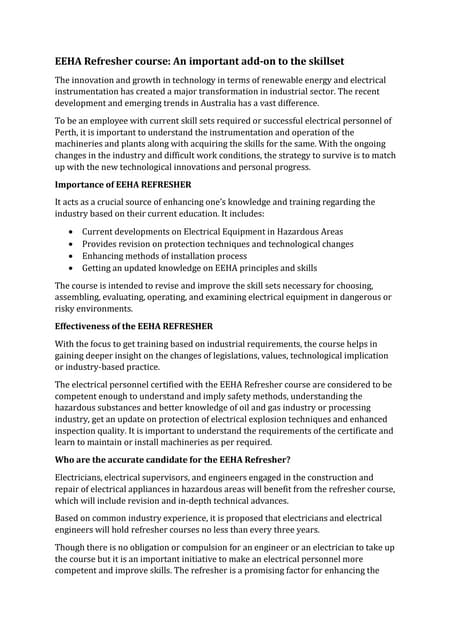The Main Principles Of Roar Solutions
The Main Principles Of Roar Solutions
Blog Article
The 5-Minute Rule for Roar Solutions
Table of ContentsRoar Solutions Things To Know Before You Get ThisThe Basic Principles Of Roar Solutions The Of Roar Solutions
In order to safeguard installments from a possible explosion an approach of evaluating and identifying a possibly harmful area is required. The function of this is to make certain the appropriate choice and installment of equipment to inevitably stop an explosion and to make sure safety and security of life.
(https://www.artstation.com/roarsolutions6/profile)
No tools needs to be installed where the surface area temperature of the tools is more than the ignition temperature of the provided risk. Below are some typical dirt unsafe and their minimal ignition temperature level. Coal Dirt 380C 225C Polythene 420C (thaws) Methyl Cellulose 420C 320C Starch 460C 435C Flour 490C 340C Sugar 490C 460C Grain Dust 510C 300C Phenolic Resin 530C > 450C Aluminium 590C > 450C PVC 700C > 450C Residue 810C 570C The chance of the risk existing in a concentration high enough to create an ignition will vary from place to place.
In order to identify this danger an installation is split into locations of risk relying on the quantity of time the hazardous exists. These locations are referred to as Areas. For gases and vapours and dirts and fibres there are three areas. Area 0 Area 20 A hazardous ambience is highly most likely to be existing and may be existing for extended periods of time (> 1000 hours annually) and even continuously Zone 1 Area 21 A hazardous ambience is feasible but unlikely to be present for extended periods of time (> 10 450 C [842 F] A classification of T6 means the minimal ignition temperature level is > 85 C [185 F] Dangerous area electric equipment possibly developed for use in greater ambient temperature levels. This would certainly showed on the score plate e.g. EExe II C T3 Ta + 60C( This implies at 60C ambient T3 will not be gone beyond) T1 T1, T2, T3, T4, T5, T6 T2 T2, T3, T4, T5, T6 T3 T3, T4, T5, T6 T4 T4, T5, T6 T5 T5, T6 T6 T6 A T Class score of T1 means the maximum surface temperature level generated by the tool at 40 C is 450 C. Presuming the linked T Course and Temperature level rating for the devices are ideal for the area, you can always use an instrument with a more rigid Department rating than required for the location. There isn't a clear solution to this concern. It really does depend upon the sort of tools and what repair work need to be performed. Devices with specific examination procedures that can not be executed in the field in order to achieve/maintain third party rating. Should come back to the factory if it is before the devices's service. Area Fixing By Authorised Personnel: Complicated screening might not be needed nonetheless details procedures might need to be complied with in order for the equipment to maintain its 3rd event ranking. Authorised personnel must be used to perform the work correctly Repair service need to be a like for like substitute. New component need to be taken into consideration as a direct substitute requiring no unique screening of the devices after the fixing is full. Each piece of devices with a dangerous ranking must be evaluated independently. These are detailed at a high degree listed below, however, for more in-depth info, please refer directly to the standards.
The 5-Second Trick For Roar Solutions
The equipment register is a comprehensive data source of tools documents that consists of a minimum collection of fields to determine each thing's location, technological parameters, Ex classification, age, and ecological data. The ratio of Comprehensive to Close inspections will be identified by the Equipment Danger, which is evaluated based on ignition threat (the chance of a resource of ignition versus the likelihood of a combustible ambience )and the hazardous area classification
( Zone 0Area 1, or 2). Implementing a durable Risk-Based Examination( RBI )technique is crucial for making certain conformity and safety and security in handling Electrical Devices in Hazardous Areas( EEHA).
How Roar Solutions can Save You Time, Stress, and Money.

In regards to explosive risk, a dangerous location is a setting in which an eruptive ambience exists (or might be anticipated to be existing) in amounts that need special preventative measures for the building, setup and usage of equipment. electrical refresher course. In this article we check out the obstacles dealt with in the workplace, the risk control measures, and the called for expertises to work safely
These substances can, in particular problems, create eruptive more helpful hints ambiences and these can have major and heartbreaking effects. Most of us are acquainted with the fire triangle get rid of any kind of one of the three components and the fire can not occur, but what does this mean in the context of dangerous areas?
In the majority of instances, we can do little concerning the levels of oxygen airborne, however we can have significant impact on resources of ignition, for instance electric tools. Hazardous locations are recorded on the harmful location classification illustration and are identified on-site by the triangular "EX" sign. Below, among other essential information, areas are split into three kinds depending on the danger, the possibility and period that an eruptive ambience will certainly exist; Area 0 or 20 is regarded the most dangerous and Area 2 or 22 is deemed the least.
Report this page